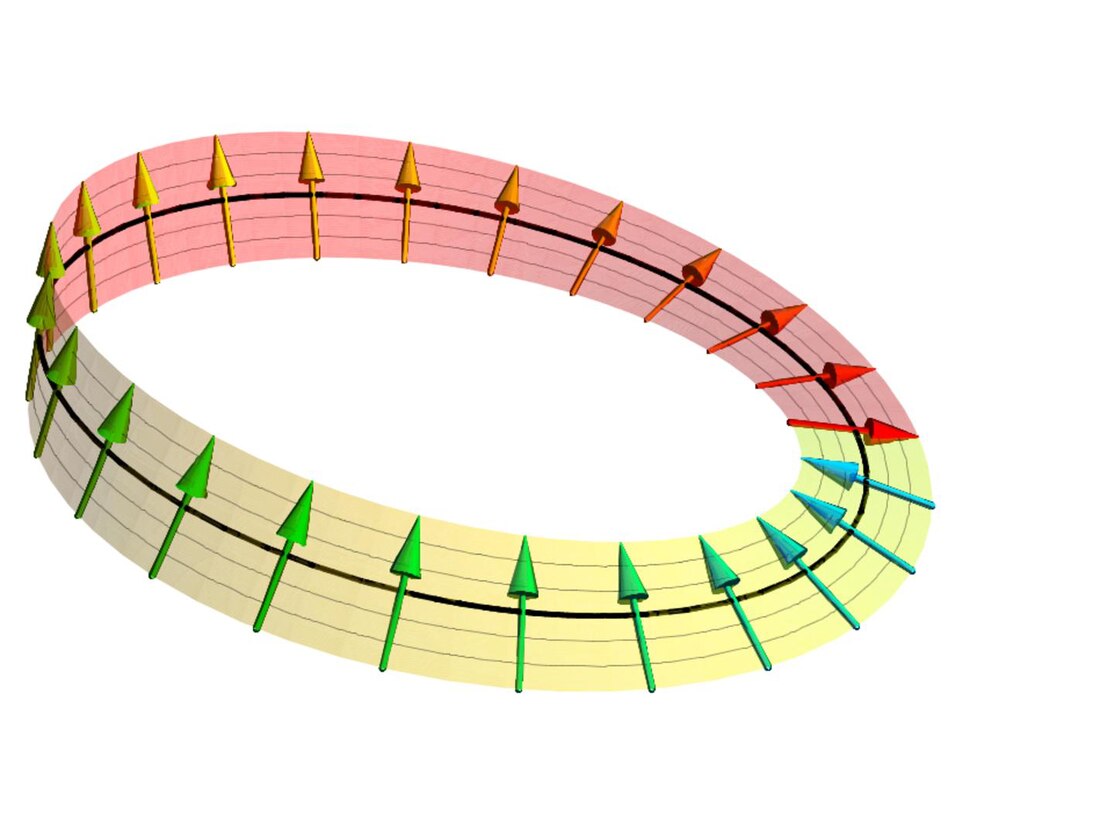热门问题
时间线
聊天
视角
旋量
来自维基百科,自由的百科全书
Remove ads
在數學幾何學與物理中,旋量(spinor)是複向量空間中的元素。旋量乃自旋群的表象,類似於歐幾里得空間中的向量以及更廣義的張量,當歐幾里得空間進行無限小旋轉時,旋量做相應的線性轉換。當如此一系列這樣的小旋轉組合成一定量的旋轉時,這些旋量轉換的次序會造成不同的組合旋轉結果,與向量或張量的情形不同。當空間從0°開始,旋轉了完整的一圈(360°),旋量發生了正負號變號(見圖),這個特徵即是旋量最大的特點。在一給定維度下,需要旋量才能完整地描述旋轉,如此引入了額外數量的維度。
此條目需要精通或熟悉相關主題的編者參與及協助編輯。 (2017年12月10日) |

在閔考斯基空間的情形,也可以定義出相似的旋量,其中狹義相對論的勞侖茲轉換扮演旋轉的角色。旋量最先是由埃利·嘉當於1913年引入幾何學。[1][2]在1920年代,物理學家發現若要描述電子及其他次原子粒子的內稟角動量或自旋,旋量為不可或缺的角色。旋量群為所有旋轉相關的旋量所構成的群,其二重覆疊了旋轉群,因為每個完整旋轉結果皆有兩種不同但等效的旋轉方式。
Remove ads
概論
一種特定的旋量是旋轉群(李群SO(n,R))的投影表示中的元素,或更廣義地說,是SO(p,q,R)群的投影表示中的元素。
旋量常被描述成「向量的平方根」,因為向量表示會出現在兩個相同旋量表示的張量積。
旋量中最典型的是狄拉克旋量。
數學性質
當前有兩種架構可建構出旋量。
一者是表示論架構。正交群的李代數中,有一些群表示無法以尋常的張量來建構,這些群表示稱之為旋量群表示,組成成分即旋量。在此觀點下,旋量屬於旋轉群的二重覆疊的表示SO(n, R);更廣義的情形,其為度規記號為(p, q)之空間中,廣義特殊正交群的二重覆疊SO+(p, q, R)。這些二重覆疊為稱作旋量群Spin(n)或Spin(p, q)的李群。
二者是幾何架構。人們可以直接建構旋量,並檢視相關李群操作下旋量的行為。此方法的優點是直觀,但對旋量的複雜性質則難以處理,例子包括菲爾茲恆等式。
歷史
埃利·嘉當於1913年提出旋量的最廣義數學形式。[3]「旋量」一詞則是首先出現在保羅·埃倫費斯特的量子物理論文中。[4]
1927年,沃爾夫岡·包立將旋量應用至數學物理,當時他引入了自旋矩陣。[5]隔年,保羅·狄拉克發現了相對論性的電子自旋理論,其中展示了旋量與勞侖茲群的關連。[6]於1930年代,狄拉克、皮亞特·海恩以及波耳研究所的其他研究者建立了Tangloids之類的玩具,作為旋量的教學以及旋量微積分的模型。
建構
克萊布希-高登係數
低維度總結
相關條目
- 狄拉克旋量
- 三維空間中的旋量
參考文獻
Wikiwand - on
Seamless Wikipedia browsing. On steroids.
Remove ads
